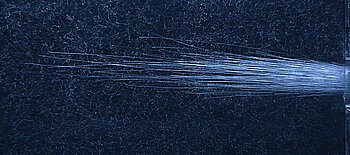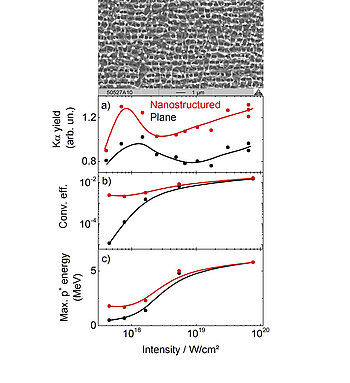If an ultra-short laser pulse (~30 fs,> 1 J) is focused on a solid-state foil so that relativistic intensities (> 1018 W / cm2) are reached, the matter is immediately transferred to a plasma state by field ionization. The electrons are accelerated in the laser field to relativistic energies. While the fastest electrons can leave the target, the slightly slower (still relativistic) electrons are trapped in the Coulomb potential of the (now) positively charged target and oscillate in this field. They form a dynamic layer (sheath) which, with the target surface, builds up an electric field of several megavolts per micrometer by extremely accelerating positive ions (e.g., protons and carbon ions from the surface contamination layer). This process is called TNSA (target normal sheath acceleration). Fig. 1 shows the recording of such a proton bunk.
Nanostructures as a guidepost for efficient laser proton accelerators
The idea behind the use of nanostructured surfaces is now quite simple: The nanostructures increase the laser absorption, d. H. More and more energetic electrons are generated, which in turn can accelerate more protons to higher energies.
But there are also other ways to optimize the TNSA mechanism - in particular, the optimization of the plasma gradient, ie. H. the density profile of the target. The applied laser intensities are so great that the ionization of the target does not first occur in the peak of the laser pulse, but starts during the pulse rise. The pre-ionized plasma expands, thereby reducing the density. The plasma gradient is therefore largely determined by the exact temporal pulse structure.
Fig. 2: Typical scanning electron micrograph of the structured titanium surface (top). The Kα yield of the structured target (a) is significantly increased over the entire intensity range investigated compared to the unstructured target and shows that the nanostructures also act at the highest intensities. On the other hand, it can be seen that the conversion efficiencies (energy transfer into fast protons) (b, logarithmic scale) and the maximum proton energies (c) of the two targets are equalized for highest intensities.
The team around Dr. Matthias Schnürer from the Max Born Institute in Berlin has now investigated the conditions under which the use of nanostructured targets is advantageous. For this purpose, the physicists have structured the targets in-situ with the laser. This method of generating laser-induced periodic surface structures is particularly simple and, in principle, as the physicists emphasize, also allows the development of a highly repetitive target system. In a first step, the surface is patterned with the attenuated laser (about 20 pulses). A scanning electron micrograph of the surface thus structured is shown in Fig. 2. Structure analysis and simulations show that the structures have nearly optimal parameters for maximum laser absorption. In the following step, the full laser pulse is focused on this structured surface. Dr. Andrea Lübcke and her colleagues carried out these investigations for different laser intensities and laser contrast, which is optimal at maximum laser intensity. First, it could be shown that the nanostructures lead to an increase of the laser absorption and thus the Kα-yield at these intensities, even at highest intensities (see Fig. 2a). For relatively small intensities, the nanostructures could significantly increase both the conversion efficiency and the proton energy over the unstructured target. So z. For example, at ~5x1017 W / cm2 the maximum proton energy is quadrupled, and the conversion efficiency from laser to proton energy has been increased by more than 2 orders of magnitude. For the highest laser intensities and the given optimal laser-plasma parameters, however, no significant use of the nanostructures for proton acceleration was measured (Figure 2b, c). The physicists of the project group speculate that there could be an effect that limits the additional energy transfer into the fastest electrons under optimal laser-plasma conditions. The team is not completely surprised by these results: As with many optimization problems, there are various optimization approaches. The combination of several of them does not usually lead to even better results. However, these experiments can not theoretically be simulated in all facets in an extreme parameter range. Thus, it is crucial to have clearly stated when the use of nanostructures is worthwhile and in which direction new theoretical investigations can be initiated.
Search publications of MBI
Publications since 2025

